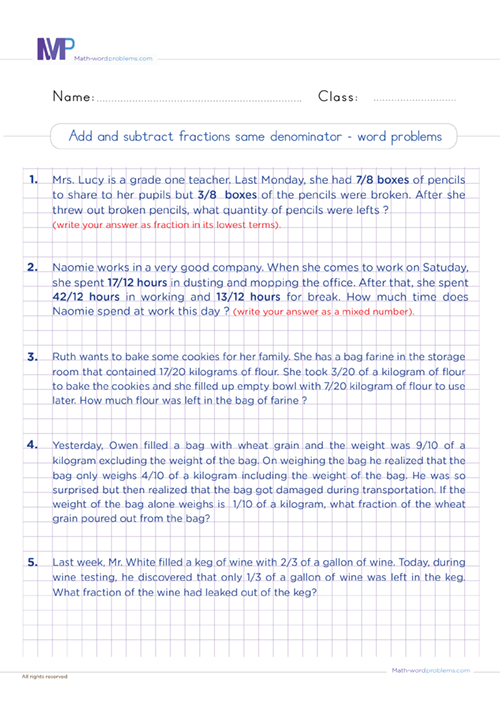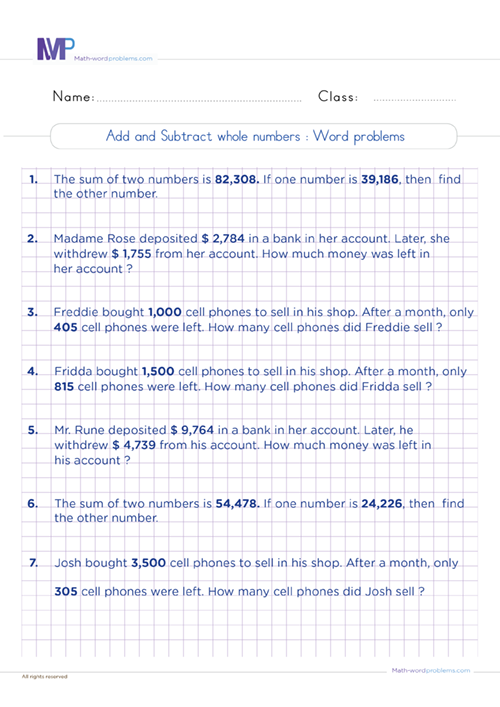 How to solve addition and subtraction of decimals word problems
How to solve addition and subtraction of decimals word problems
This resource is here to help 6th graders learn how to solve addition and subtraction of decimals word problems in the most straightforward way. Let’s follow the exciting step-by-step guide below and enjoy it while solving.
Interestingly, this fantastic step-by-step guide consists of thrilling strategies, tips, and straight-to-the-point short steps that will provide accurate answers and also enable kids to understand what the problem is describing and relate it to real-life situations. Furthermore, this outstanding resource will guide and inspire kids to use their thinking skills when encountering word problems. As such, they will significantly enhance their problem-solving competencies. Once you engage in this resource, you’ll realize there is no fun and exciting way of solving word problems other than using our fantastic resource.
Steps to Solve Addition and Subtraction of Decimals Word Problems
Here are simple steps to solve addition and subtraction of whole numbers word problems.
We want to help 6th graders encounter and do more complex but exciting word problems using addition and subtraction of decimals solving steps. For this reason, we will attach some extraordinary real-life examples for you to see how incredible these steps work.
Step 1: IDENTIFY:
This is the most crucial part i.e. identifying the problem statement in any given word problem. After reading the problem and understanding it very well, try to figure out the important numbers and keywords in the word problem.
- Whenever you come across adding a decimal word problem, you will see at least one of the keywords below: - add, plus, more, total, increase, together, Altogether, combined, sum, grow, join, both, in all, and, how many in all, how much, etc.
- Now, when coming to subtracting a decimal word problem, some of the significant keywords you’ll see are: - less, minus, take away, left, decrease, difference, fewer, deduct, remain, change, how many more, leftover, less than, how much longer/shorter, fewer than, discount, etc.
- ***One key Element for learners to understand is that they should not always rely on keywords alone. That is to say; the same keyword can have different meanings in different word problems.
For this reason, we reiterate on the importance of reading the question very carefully to understand the situation that the word problem is describing, then figure out exactly which operation to use***
Step 2: STRATEGIZE:
How will you solve or tackle the word problem?
- Now, from the keyword(s) in the word problem, you will easily determine if you need to add or subtract.
- But it would be best not to depend only on those keywords. Rather, try to understand the situation that the problem is describing before you start solving it.
- With this in mind, construct short and precise expressions/sentences to represent the given word problem.
Step 3: SET UP OR BEGIN:
From the knowledge you got from step 2 above, you can now write down a numerical expression representing the information in the word problem.
Step 4: PROVIDE A SOLUTION:
From Step 3 above, add or subtract the decimal values by arranging the decimal points to line up using the column method. Also, use zeros as place value holders if need be. Furthermore, do not forget to add the unit of measurement to your final answer, if any.
Step 5: CHECK YOUR WORK:
Lastly, ask yourself this question. “Does my answer make sense?” If “YES,” you are done. If “NO,” go back to step 1 and start all over again.
Examples on how to solve addition and subtraction of decimals word problems.
Example one: How to solve addition of decimals word problems?
Step 1: To begin, read the problem carefully. After carefully reading the problem, the important numbers you’ll come across are $9.30 and $50.9. Also, the keyword in the word problem is “left.”
Step 2: As you move to this step, you’ll ask yourself: “How will I solve this problem?”
From the keyword “left and the scenario that the word problem is presenting, you are expected to perform a subtraction operation.
Now, construct short expressions/sentences to represent the given word problem.
- Amount of money that I had = $50.9.
- Amount of money that I spent = $9.30.
- Therefore, the amount of money that I have left to buy other snacks = the amount that I had – the amount I spent.
Step 3:Next, write down a numerical expression/ a mathematical equation to represent the bolded sentence in step 2 above:
$50.9 - $9.30 = ?
Step 4: From step 3 above, arrange or stack the values so that the decimal points will line up in the minuend, subtrahend, and difference (using the column method). Also, use zeros as place values here because it is needed. Then, go ahead and subtract the values. Remember to add the unit of measurement to your final answer, if any.
So, I have $41.60 left to buy other snacks
Step 5: To conclude, check out your work to know if your answer makes sense, i.e., by estimating the numbers and calculating mentally. If the answer is so close to the one you have, then your answer is correct but if the answer is not close to your answer, go back to step 1.
Example two: How do we solve subtraction of decimal word problems?
Step 1: After reading the problem discretely, the important numbers you’ll find are 205.7 kilograms and 78,690 grams. As you move on, the keyword you’ll find in the word problem is “total.”
Step 2: As you move to this step, you’ll ask yourself: “How will I solve this problem?”
Next, How will you solve the problem? From the keyword(s) “total” and the situation that the word problem is describing, you will need to perform an addition operation.
Now that you know the operation you will perform, construct short expressions/sentences to represent the given word problem.
- Quantity of potatoes in the bag = 205.7kg.
- Quantity of apples in another bag = 78,690g.
- Therefore, the weight of all the bags = the quantity of potatoes in the bag + the quantity of apples in another bag.
Step 3:Then, write down a numerical expression to represent the bolded sentence in step 2 above:
205.7kg + 78,690g = ?
Step 4: From step 3 above, arrange the values so that the decimal points will line up in the addends and sum (i.e., use the column method). Also, use zeros as place value holders here because it is needed. Then, go ahead and add the values. Always recall adding the unit of measurement to your final answer, if any.
** But you cannot add kilograms and grams. You have to convert to one unit before you proceed. Remember it is mentioned in the word problem that you have to give the total weight of the bags in kilograms. So, you have to visit your metric unit of measurement of weight conversion table to convert 78,690 grams to kilograms.
If 1000g = 1kg,
Then, 78,690g = (78,690 ÷ 1000)kg = 78.69kg
Now,205.78kg + 78,690g = 205.78kg + 78. 69kg = ?
So, the total weight of all the bags is 284.39 kilograms
Step 5: Finally, check out your work to know if your answer makes sense, i.e., by estimating the numbers and calculating mentally. If the answer is so close to the one you have, then your answer is correct but if the answer is not close to your answer, then go back to step





